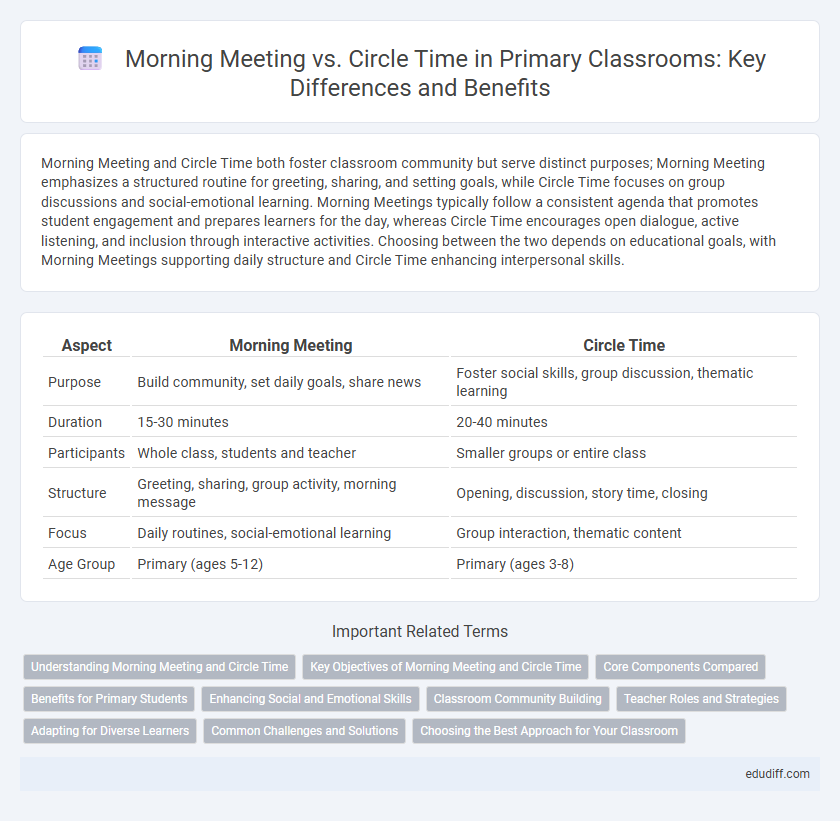Morning Meeting and Circle Time both foster classroom community but serve distinct purposes; Morning Meeting emphasizes a structured routine for greeting, sharing, and setting goals, while Circle Time focuses on group discussions and social-emotional learning. Morning Meetings typically follow a consistent agenda that promotes student engagement and prepares learners for the day, whereas Circle Time encourages open dialogue, active listening, and inclusion through interactive activities. Choosing between the two depends on educational goals, with Morning Meetings supporting daily structure and Circle Time enhancing interpersonal skills.
Table of Comparison
| Aspect | Morning Meeting | Circle Time |
|---|---|---|
| Purpose | Build community, set daily goals, share news | Foster social skills, group discussion, thematic learning |
| Duration | 15-30 minutes | 20-40 minutes |
| Participants | Whole class, students and teacher | Smaller groups or entire class |
| Structure | Greeting, sharing, group activity, morning message | Opening, discussion, story time, closing |
| Focus | Daily routines, social-emotional learning | Group interaction, thematic content |
| Age Group | Primary (ages 5-12) | Primary (ages 3-8) |
Understanding Morning Meeting and Circle Time
Morning Meeting is a structured routine that fosters a positive classroom community by incorporating greeting, sharing, group activity, and message segments to build social-emotional skills and set a purposeful tone for the day. Circle Time serves as an interactive group session where children engage in focused discussions, storytelling, and collaborative activities to enhance language development and cooperative learning. Understanding the distinctions between Morning Meeting and Circle Time helps educators implement strategies that support student engagement and academic readiness effectively.
Key Objectives of Morning Meeting and Circle Time
Morning Meeting focuses on building community, setting a positive tone for the day, and fostering social-emotional skills through greeting, sharing, and group activities. Circle Time aims to enhance communication, develop listening skills, and support academic learning by engaging children in structured discussions and thematic lessons. Both promote student engagement and classroom cohesion but differ in structure and emphasis on social versus academic objectives.
Core Components Compared
Morning Meeting emphasizes a structured format with four core components: greeting, sharing, group activity, and morning message, designed to build community and set a positive tone for the day. Circle Time typically includes open-ended discussions, storytelling, and interactive activities that promote social skills and emotional development in a more flexible structure. Both formats prioritize student engagement and social interaction but differ in their level of structure and specific daily objectives within primary education settings.
Benefits for Primary Students
Morning Meeting fosters a structured environment that promotes social-emotional learning, enhances communication skills, and builds a sense of community among primary students. Circle Time encourages active participation, improves listening skills, and supports peer interaction through sharing experiences and collaborative activities. Both approaches contribute significantly to creating a positive classroom atmosphere that supports emotional regulation and academic readiness in early childhood education.
Enhancing Social and Emotional Skills
Morning Meeting and Circle Time both serve as structured opportunities to enhance social and emotional skills in early childhood education. Morning Meeting typically integrates greeting, sharing, and group activities to build community and communication skills among students. Circle Time emphasizes listening, empathy, and turn-taking, fostering emotional regulation and cooperative learning within a supportive setting.
Classroom Community Building
Morning Meeting and Circle Time are essential routines for fostering classroom community building by promoting student engagement, social-emotional skills, and a sense of belonging. Morning Meeting integrates greeting, sharing, group activities, and message components to establish a consistent start that supports communication and collaboration among students. Circle Time emphasizes inclusive discussion and interactive activities, enhancing peer relationships and collective problem-solving within a supportive classroom environment.
Teacher Roles and Strategies
Teacher roles in Morning Meeting emphasize leadership and facilitation, guiding students through greeting, sharing, and group activities to build community and establish routines. In Circle Time, educators adopt a more interactive role, encouraging student participation and dialogue to enhance social-emotional learning and cooperative skills. Effective strategies include using open-ended questions during Circle Time and consistent, structured rituals in Morning Meeting to foster engagement and classroom cohesion.
Adapting for Diverse Learners
Morning meetings and circle time serve as foundational routines in primary classrooms, but adapting these formats to meet the needs of diverse learners requires differentiated strategies. Incorporating visual supports, flexible seating, and varied communication methods during these sessions enhances engagement for students with different learning styles or language proficiencies. Tailoring activities to include culturally responsive content and allowing multiple modes of participation ensures inclusivity and promotes social-emotional growth among all young learners.
Common Challenges and Solutions
Common challenges during Morning Meetings and Circle Time include maintaining student engagement, managing diverse participation levels, and addressing off-topic discussions. Implementing structured agendas with clear time limits and using interactive activities tailored to varying attention spans can enhance focus and involvement. Consistent routines combined with positive reinforcement strategies help create an inclusive environment that supports effective communication and collaboration.
Choosing the Best Approach for Your Classroom
Morning meetings foster a structured environment emphasizing social-emotional learning, student engagement, and clear daily expectations, while circle time encourages open dialogue and collaborative problem-solving in a more informal setting. Selecting the best approach depends on classroom dynamics, age group, and learning objectives, with morning meetings often preferred for elementary students needing routine and circle time suited for younger children requiring flexible interaction. Teachers should assess student needs, class size, and desired outcomes to effectively integrate the method that maximizes participation and builds community.
Morning Meeting vs Circle Time Infographic

 edudiff.com
edudiff.com